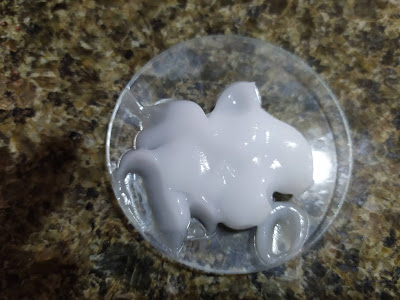Traditional
cosmetic emulsifiers (a.k.a. hot process emulsifiers) are quite tricky to use
for amateur cosmetic formulators like me. I can’t count the number of times
that I wasted my raw materials because my lotion has separated after a few
days. So when I finally got my hand on Novemer
EC-2, making lotions and creams become easy peasy! It is a cold process
emulsifier so basically you don’t need to heat your water and oil phases at
same temperature and wait for the emulsion to cool down before adding
heat-sensitive ingredients. Since it is a liquid emulsifier, there is no need
to melt it unlike solid emulsifiers. You can actually make a basic lotion with Novemer EC-2 in just 5 minutes with
just manual hand stirring.
What is Novemer EC-2?
INCI:
Sodium Acrylates/ Beheneth-25 Methacrylate Crosspolymer (and) Hydrogenated
Polydecene (and) Lauryl Glucoside
Manufacturer: Lubrizol
Description: It's a multi-functional, synthetic
(pre-neutralized) liquid polymer that can be used to make oil-in-water emulsions.
Functions
- It can be used as emulsifier or co-emulsifier in either hot or cold process emulsion.
- It helps thicken and improve the texture of the emulsion.
- It helps stabilize emulsion.
Features
- Can tolerate electrolytes (e.g. aloe vera)
- Can tolerate high pH (pH range 5.5 – 11). The ideal pH for more stable emulsion is 6.5
- Can suspend inorganic pigments (e.g. iron oxide, titanium dioxide)
- Can emulsify broad range of oils
- Can make emulsion with excellent skin sensory properties
- Has low potential to cause skin irritation or sensitization
Where to Use Novemer EC-2?
- Facial lotion
- Facial cream
- Body lotion
- Body cream
- Sun care lotion and cream
- Gel lotion / Gel cream / Hydrogel
Formulation Guidelines
- Usage rate is 0.5 - 5%
- Can either be added to water phase or oil phase
- Can be added post-emulsion to adjust the viscosity of the final product
- Can be combined with Carbopol polymers to form more stable emulsion that is highly electrolyte resistant
Experiment Details
For
my formulation experiment, I decided to create two batches of 10g emulsion
using 1% and 5% Novemer EC-2, respectively. Basically, the formula will only
contain 3 ingredients: water, oil and Novemer EC-2. I used sunflower oil at
fixed amount of 5% for both sample batches. I also used cold process method in
making the emulsion.
|
|
BATCH
1 |
BATCH
2 |
|
NOVEMER EC-2 |
1% |
5% |
|
WATER |
94% |
90% |
|
SUNFLOWER OIL |
5% |
5% |
The
formulation process is as follows:
- In a glass beaker, add Novemer EC-2 to water and mix until homogeneous.
- Add the oil into the Novemer EC-2 + water mixture and mix until homogeneous.
Experiment Results
|
|
NOVEMER
EC-2 @ 1% |
NOVEMER
EC-2 @ 5% |
|
APPEARANCE |
More translucent (like a hydrogel/gel lotion) |
More opaque |
|
SKIN FEEL |
Light, non-sticky and absorbs quickly |
Light, non-sticky and absorbs quickly |
|
VISCOSITY |
Thin consistency |
Thick consistency |
Here
is the video of the Novemer EC-2 presentation
and actual experiment I made.
If you’re interested to know more about cosmetic formulation, please subscribe to my YouTube channel – Cosmetic Formulation Diary.
Have
you tried Novemer EC-2 in your
cosmetic formulations? Share your experience on the comment section below J
P.S.
To always get the latest blog updates, don’t forget to follow me on Facebook.




No comments:
Post a Comment